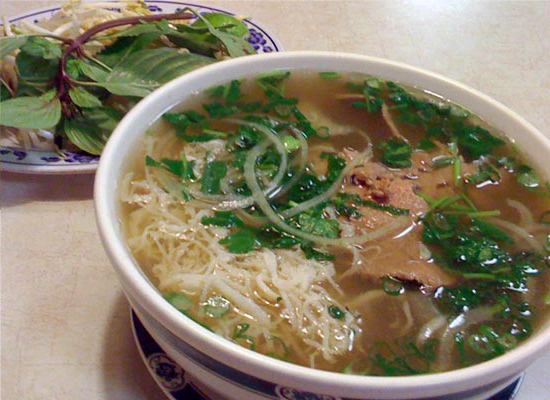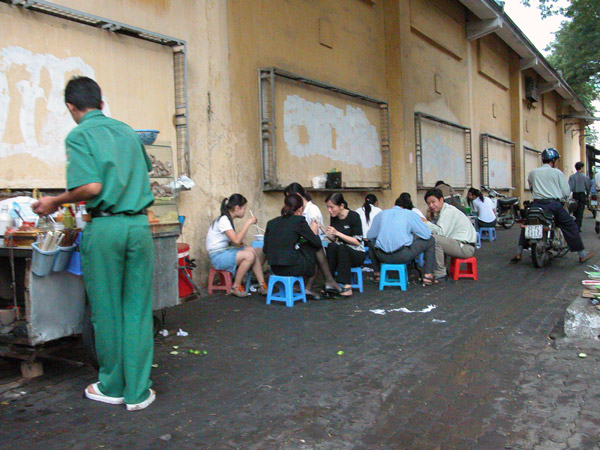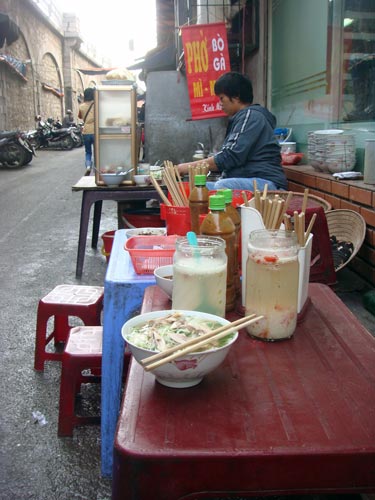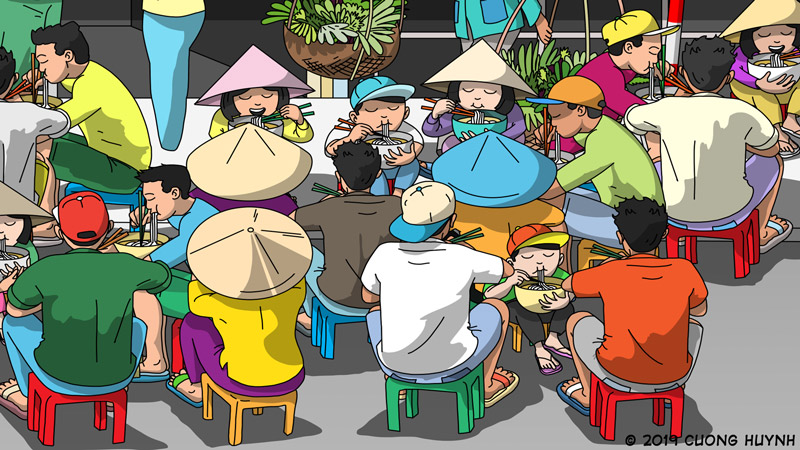Updated 04-17-19. Among all the Vietnamese dishes that came to the attention of the people in the western hemisphere, nothing else has received such tremendous acceptance as pho. Pho is considered as the national dish of Vietnam, and it has captured the fascination of so many people in the west because of its deceptive simplicity and its complex flavors. Pho is the perfect comfort food - warm, hearty and deliciously refreshing. In Vietnam it's the common people's food. It's street food.
Pho can also be seen as a mirror that reflects Vietnamese heritage and way of life. A dish that is steeped in tradition, pho is closely tied to Vietnam that the history of pho can read as a parallel to the history of its country of origin itself in the last hundred years. With the migration of Vietnamese across the globe after the Fall of Saigon in 1975, the national dish of Vietnam came to grace the tables of people of different heritages, thus leading to the colorful evolution of pho throughout the years. In this article I'll discuss pho, its history and what makes pho many people's favorite dish.
What Is Pho?
Of course, before I go into the history of pho, we should first tackle a more fundamental question about pho, namely: What in the world is pho?
Many readers know exactly what pho is. Articles on pho that you find around the Internet define the dish simply as Vietnamese noodle soup, traditionally made with beef or chicken broth that is flavored with various spices and topped with various herbs. But this definition seems far too simplistic because it does not really capture the rich and intense essence of beef in the broth that can only be achieved by simmering marrow-rich beef bones on low heat for many hours. It does not describe the complex layers of flavor created by the herbs and spices in pho. It does not illustrate the many textures created by the square rice noodles, the tender beef slices and the crunchy bean sprouts in the soup.
At the very least, the description "noodle soup" may be a misnomer. Soup implies that the dish is a side dish, but in fact pho itself is the main course. Pho is a noodle dish, and not a soup dish. So if you catch the phrase "noodle soup" somewhere on this site then it's only because I let my guard down for a moment there. Pho should be called "Vietnamese noodle" or "soup noodle" because it is a noodle dish.
You cannot expect two bowls of pho made in two separate kitchens to ever taste the same. There are many recipes of pho existing out there, with each recipe somewhat different from each other. But those are only the published ones. There are countless others that are closely held by professional chefs running popular pho restaurants, and we'll never know what they are. So techniques in cooking and preparing pho vary from chef to chef. Variations can also depend on what type of pho is being prepared. For instance, pho bac, which is pho from the northern regions of Vietnam, is made quite differently from how pho is prepared and served in southern Vietnam.
The history of pho stretches only a hundred years back in Vietnam's recent past. But just as those hundred years have shaped Vietnam into the country it is today, so do those hundred years have shaped the way pho has become. Three events in Vietnamese history have marked the history of pho. They are
- The unification of Vietnam under French rule in 1887,
- The splitting of the country into North and South Vietnam in 1954, and
- The Fall of Saigon in 1975.
Editor's Note: Here's an article on "What is Vietnamese Pho: Think You Know? Think Again," which discusses what is and what is not pho.
The Murky Beginnings of Pho: a French Connection?
Despite the fact that pho is a reflection of the culture and history of Vietnam, no one really knows how pho came to be. Restaurateur and author Mai Pham's research on pho, as cited in Vietnamese culinary expert Andrea Nguyen's blog, stated that there is nothing written about the early history of pho. All there is left are oral traditions handed down by elders. It is, however, agreed upon by many experts in Vietnamese cuisine, including Ms. Pham and Ms. Nguyen, that the history of pho began in Nam Dinh/Hanoi region in northern Vietnam and that it started around the time when the French colonized the country in the late 1880s.
In the SpiceLines interview on Ms. Nguyen, she said that before the French conquered Vietnam, the Vietnamese people did not slaughter cows for food. Instead, they used these animals to till their rice fields and as beasts of burden.
The general theory held by most Vietnamese culinary experts is that the word "pho" is a corruption of the French "feu" or "fire." Pho could be a Vietnamese adaptation of the French soup "pot au feu" or French beef stew, which the French brought to Vietnam when they came to rule the country. But let me take this theory further into something more concrete to possibly reflect facts. It is this: Vietnamese love to take foreign words and use them as our own, but with a Vietnamese accent. Thus "feu" became "Phở." But there's more. It's always been a popular knowledge that the French, specifically a man named Jesuit Alexandre de Rhodes in the country between 1624 and 1644, helped convert Vietnamese written language from a variant of Chinese characters into the modern age with translations using the Latin alphabet system. So the French connection to pho and Vietnamese language is much more intimate than casual, and it's not unthinkable that pho did come from feu. Read more on the Vietnamese alphabet.
"Pot au feu" literally means "pot on the fire," signifying the long hours required to create the soup. Just like with pho, cartilaginous, marrow-rich beef bones are used to make the broth of the pot au feu. These bones are left to boil and simmer in water on low heat for at least three hours, and the scum and foam formed by excess grease from the bone marrow are skimmed and discarded.
Another similarity that pot au feu shares with pho is the fact that ginger and onions are also roasted in an open flame before they are added to flavor the broth. Vegetables like carrots and turnips are used to top pot au feu. In pho, these vegetables are replaced by bean sprouts and herbs, with a little lime juice added in for taste.
Pho Bac: Pho of the North
Another theory that Vietnamese cuisine experts agree on is that the birthplace of pho is northern Vietnam, near Hanoi. Given the theory that pho is a Vietnamese adaptation of the French pot au feu, it is not surprising to think that pho originated from the north.
Hanoi has always been the center of political power in colonial Vietnam, with only a few short interruptions. The city has always been the seat of Vietnamese kings and emperors since 1010, except during the rule of the Nguyen dynasty, when the capital was moved to Hue. When the French conquered Vietnam and established the colony they called the French Indochina, they made Hanoi their capital city.
The French brought pot au feu to Vietnam and introduced the idea of slaughtering cows for food to the Vietnamese of the north. The northern regions of Vietnam are not as rich as those in the south, and food scarcity may have been a way of life in a northern Vietnamese household. The northern Vietnamese get their food where they can find it, and they learned to take the beef parts and bones that their French conquerors did not want for their table. It is widely believed that this is how pho of the north, called pho bac, came to be.
Pho bac has an intense and delicate flavor that is entirely different from pho nam, which is pho of the south. The focus of pho bac is on the taste of its clear and simple broth. The star anise and other spices commonly used in pho serve as subtle undertones of flavor rather than complex layers. The main ingredients in pho bac are the rice noodles and the thinly sliced rare beef cooked quickly in the hot broth. You would not find a bowl of pho bac topped with the popular herbs and garnishing found in pho nam or in pho outside of Vietnam.
Even today, northern Vietnamese and pho purists consider pho bac the true pho. It is not uncommon to find a person from northern Vietnam or a pho purist to turn away from lavish preparations of pho nam or from pho that is not made from beef stock. A few purists may even find such preparations shocking and disgusting.
Pho Nam: Pho of the South
French rule did not last in Vietnam. The Second World War saw the country known as French Indochina fall under Japanese occupation, although the new Japanese rulers retained their French administrators. But France was not to regain her full political influence on Vietnam. After World War II, a series of events led to the splitting of Vietnam into North Vietnam and South Vietnam in 1954. North Vietnam, which is Communist country, kept Hanoi (Hà Nội) as its capital. South Vietnam is a democracy centered on Saigon (or Sài Gòn).
Thousands of North Vietnamese fled the Communist rule, and escaped across the border to South Vietnam. These refugee families took with them their cherished pho recipes and introduced pho to their brethren in the south. Here, pho is to make a turn that eventually shocked pho purists from the north.
Unlike in North Vietnam, food is rich and abundant in South Vietnam. Herbs and other ingredients are used liberally. The Vietnamese of the south put their taste for the lavish on the frugal pho bac to create the classic pho nam. They put more spices in their pho than their northern counterparts. They experimented with other beef parts, and even used other ingredients such as chicken and tripe. They added bean sprouts and herb garnishing as topping on the soup. They were also very liberal about the use of fish sauce and hoisin sauce to flavor their pho.
Pho flourished, and due to its versatility and popularity, Vietnamese eat pho everyday, at any time during the day. Pho vendors do business everywhere, from pushcarts to neighborhood street stalls, from pho restaurants to elegant bistros. But most importantly, pho is the food of the working people.
The Fall of Saigon and the Evolution of Pho
Conflicts between North and South Vietnam continued long after 1954. These conflicts were fueled by the Communist superpowers, namely the Soviet Union and Communist China, who gave their support to Communist North. Into the fray also came the Americans, who favored the Democratic South Vietnam. The conflicts became known as the Vietnam War, which raged full scale from 1963 to 1973, and ended in the Fall of Saigon in 1975.
The Fall of Saigon saw masses of Vietnamese refugees flee for their lives to various corners of the world; I'm one of those refugees. Many were accepted to the United States in the few years immediately after 1975, while many others tried to escape in rickety boats as "boat people" for 15 or more years to come. These Vietnamese boat people created colonies in neighboring countries such as Malaysia, Indonesia and the Philippines, although some even reached as far as Australia and even Europe.
Among the treasures that Vietnamese refugees brought with them from their homeland were their cherished pho recipes. South Vietnamese (including Northern Vietnamese who fled to the South in 1954) were by far the majority of the refugees and what they brought with them was the Southern style pho. Before long, restaurants serving pho emerged in the communities these Vietnamese migrants established in their country of exile, and these restaurants introduced pho to their non-Vietnamese neighbors.
As time went on, an evolution of pho was seen outside of Vietnam. Although the basic ingredients were retained, pho recipes were adapted to suit whatever ingredients were available locally, and to also cater to local tastes. Non-Vietnamese who attempted to create their own versions of pho also used techniques and ingredients that are far away from the traditional methods of creating pho.
One cannot stop evolution. Personally, I admire the creativity of these chefs, but if you want good pho, then go where the crowd eats. Chances are they eat the more authentic kind.
Vietnamese Pho Today
Many Vietnamese, myself included, are taking upon ourselves to help pho retain its traditional identity. Pho has nonetheless taken on an adaptive nature both inside and outside of Vietnam. Many versions of pho have emerged to contain seafood and pork and are called "pho" by their creators. To me they are not pho; they're just marketing schemes to sell non-red meat alternatives to customers and/or just offer more choices for the sake of more choices.
The fact remains that pho has captured the fascination of people from all over the world because of the appeal of its distinct and layered flavors. There's no question you'll find great tasting and authentic pho in many local pho shops near where you live. Wherever you are in the world - whether in the United States, Canada, Europe, Australia or other Asian countries - you are sure to find a Vietnamese restaurant that serves good, authentic pho.
Undoubtedly, pho will continue to naturally and organically evolve both inside and outside of Vietnam. No one can stop this process from happening. I'm just proud knowing that, from all the wars and conflicts and colonialism that Vietnam people have had to endure, Vietnamese pho has become a comfort food that millions throughout the world enjoy.
I hope you enjoyed reading this article and welcome your comments, corrections and suggestions. Share them with us in the comments below.
- Also see “Pho in the U.S.: Sweeping North America Since 1975“.
- For an excellent recount of the Vietnamese experience and history of Little Saigon, see “Little Saigon, Orange County – California” by Wandering Chopsticks.
- Also check out “Vietnamese, Little Saigon, Bolsa, and Pho by the Numbers“.
This is a great article. It basically sums up all the information I've came across in my research.
@Casey. Thanks for the kind words. And you have an awesome site yourself. Love 'em photos!
I want to make a poster out of your article, please let me know if that is ok with you? I will hang it in my new restaurant. Thanks
@Got to have it: I've sent you a private message via email.
Hello Cuong Huynh,
Thank you for an informative article on Pho. I am making a documentary on Pho and would love to have an interview with you. Please let me know if you'll be interested.
Thank you.
Wow! I'm very fascinated by this article. I find it truly informative. It explains the background of "PHO' to a whole new level. I too would also like to post this in my restaurant for everyone to see. Please tell me your thoughts.
Respectfully,
~ Van
Hi Van: What would you like to do? Please send me a private message via the Contact page.





